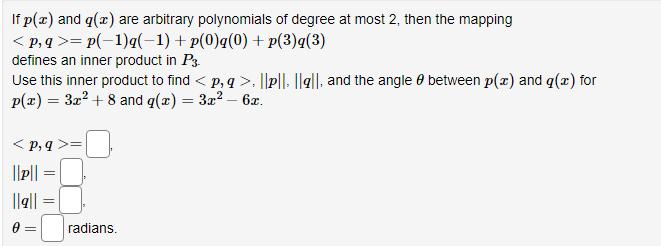Question
If p(x) and g(x) are arbitrary polynomials of degree at most 2, then the mapping < p, q>= p(-1)q(-1) + p(0)q(0) + p(3)q(3) defines

If p(x) and g(x) are arbitrary polynomials of degree at most 2, then the mapping < p, q>= p(-1)q(-1) + p(0)q(0) + p(3)q(3) defines an inner product in P3- Use this inner product to find < p, q>. ||p|| ||g||, and the angle between p(x) and g(x) for p(x) = 3x +8 and g(x) = 3x - 6x. < P, q ||p|| ||g|| = = = radians.
Step by Step Solution
3.48 Rating (164 Votes )
There are 3 Steps involved in it
Step: 1
solution p q 311 300 333 30 The inner product of two polynomials px and qx is a measure of the si...
Get Instant Access to Expert-Tailored Solutions
See step-by-step solutions with expert insights and AI powered tools for academic success
Step: 2

Step: 3

Ace Your Homework with AI
Get the answers you need in no time with our AI-driven, step-by-step assistance
Get StartedRecommended Textbook for
Linear Algebra A Modern Introduction
Authors: David Poole
4th edition
1285463242, 978-1285982830, 1285982835, 978-1285463247
Students also viewed these Accounting questions
Question
Answered: 1 week ago
Question
Answered: 1 week ago
Question
Answered: 1 week ago
Question
Answered: 1 week ago
Question
Answered: 1 week ago
Question
Answered: 1 week ago
Question
Answered: 1 week ago
Question
Answered: 1 week ago
Question
Answered: 1 week ago
Question
Answered: 1 week ago
Question
Answered: 1 week ago
Question
Answered: 1 week ago
Question
Answered: 1 week ago
Question
Answered: 1 week ago
Question
Answered: 1 week ago
Question
Answered: 1 week ago
Question
Answered: 1 week ago
Question
Answered: 1 week ago
View Answer in SolutionInn App



